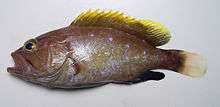Pseudorhabdosynochus firmicoleatus
| Pseudorhabdosynochus firmicoleatus | |
|---|---|
 | |
| Body and sclerotised parts | |
| Scientific classification | |
| Kingdom: | Animalia |
| Phylum: | Platyhelminthes |
| Class: | Monogenea |
| Subclass: | Monopisthocotylea |
| Family: | Diplectanidae |
| Genus: | Pseudorhabdosynochus |
| Species: | firmicoleatus |
| Binomial name | |
| Pseudorhabdosynochus firmicoleatus Kritsky, Bakenhaster & Adams, 2015 | |
Pseudorhabdosynochus firmicoleatus is a diplectanid monogenean parasitic on the gills of the Yellowedge grouper, Epinephelus flavolimbatus and the Snowy grouper, Epinephelus niveatus. It as been described by Kritsky, Bakenhaster and Adams in 2015. [1]
Description
Pseudorhabdosynochus firmicoleatus is a small monogenean, 400-500 µm in length.[1] The species has the general characteristics of other species of Pseudorhabdosynochus, with a flat body and a posterior haptor, which is the organ by which the monogenean attaches itself to the gill of is host. The haptor bears two squamodiscs, one ventral and one dorsal. The sclerotized male copulatory organ, or "quadriloculate organ", has the shape of a bean with four internal chambers, as in other species of Pseudorhabdosynochus.[2] The vagina includes a sclerotized part, which is a complex structure.
Diagnosis

Kritsky, Bakenhaster & Adams (2015) wrote that Pseudorhabdosynochus firmicoleatus most closely resembles Pseudorhabdosynochus sulamericanus (a species described by Santos, Buchmann and Gibson in 2000 [3]) in the general morphology of the vaginal sclerite. The structure in both species possesses a delicate distal funnel at its attachment to the vaginal vestibule, a proximal bulge of the distal tube, and a small chamber. In P. firmicoleatus, however, the vaginal sclerite is delicate and lacks the irregular sclerites along the distal tube typical of P. sulamericanus. It further differs from P. sulamericanus in that the deep root of the ventral anchor has its proximal end directed dorsally. Finally, tegumental scales are lacking and the squamodiscs of P. firmicoleatus have 11–13 rows of rodlets, vs tegumental scales present and 14–17 rows in the squamodics of P. sulamericanus). No significant differences were observed between specimens of P. firmicoleatus collected from yellowedge and snowy groupers.[1]
Hosts and localities

The type-host is the Yellowedge grouper, Epinephelus flavolimbatus; the species has also been found on the gills of the Snowy grouper, Epinephelus niveatus.[1] The type-locality is the open Gulf of Mexico, 70 miles south of Panama City, Florida. The record on the Snowy grouper is from the Gulf of Mexico, 60 miles south-west of Pensacola, Florida.
References
- 1 2 3 4 Kritsky, Delane C.; Bakenhaster, Micah D.; Adams, Douglas H. (2015). "Pseudorhabdosynochus species (Monogenoidea, Diplectanidae) parasitizing groupers (Serranidae, Epinephelinae, Epinephelini) in the western Atlantic Ocean and adjacent waters, with descriptions of 13 new species". Parasite. 22: 24. doi:10.1051/parasite/2015024. ISSN 1776-1042. PMC 4536336
 . PMID 26272242.
. PMID 26272242. 
- ↑ Kritsky, D. C. & Beverley-Burton, M. 1986: The status of Pseudorhabdosynochus Yamaguti, 1958, and Cycloplectanum Oliver, 1968 (Monogenea: Diplectanidae). Proceedings of the Biological Society of Washington, 99, 17-20. PDF

- ↑ Santos, Cláudia Portes; Buchmann, Kurt; Gibson, David I. (2000). "Pseudorhabdosynochus spp. (Monogenea: Diplectanidae) from the gills of Epinephelus spp. in Brazilian waters". Systematic Parasitology. 45 (2): 145–153. doi:10.1023/A:1006232029426. ISSN 0165-5752.